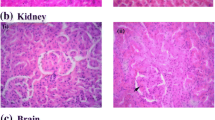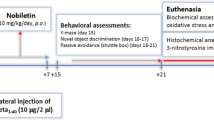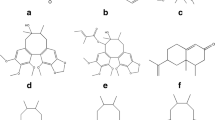Abstract
Background
Studies showed the protective role of Salvia in traditional medicine against neurodegenerative diseases. Salvia macilenta is one of the potent antioxidant herbs among Salvia species against oxidative stress. In the current study, the effect of oral administration of S. macilenta in the antioxidant, anti-inflammatory activities of Aβ-injected male albino Wistar rats was determined.
Methods
Rats were received S. macilenta (50 mg/kg/day) orally, for ten successive days and then some of them received Aβ (10 ng/µl) in their hippocampus (CA1 region). Proteins involved in antioxidant defense system and inflammatory signaling pathways in the hippocampus and prefrontal cortex were evaluated using Western blotting technique. To study apoptosis, Western blotting technique and histological staining were used. Catalase activity, glutathione peroxidase (GSH) and nitric oxide levels were measured.
Results
Results demonstrated that S. macilenta increased Nrf2 protein level and decreased TNFα and IL-6 protein level in Aβ-injected rats compared to the Aβ-injected group in the hippocampus and prefrontal cortex. Histological analysis showed pretreatment with S. macilenta decreased apoptosis levels in the hippocampus and prefrontal cortex, about 41 and 42%, compared to Aβ-injected rats, respectively. This study showed that catalase activity was changed in the S. macilenta + Aβ group compared to the Aβ-injected rats. Also, GSH level was increased in the S. macilenta + Aβ group compared to the Aβ-injected rat.
Conclusion
Orally treatment of S. macilenta extract in Aβ-injected rats could ameliorate protective pathways and, so, it can be one of the proposed dietary supplements for the prevention of Alzheimer’s disease and dementia.




Similar content being viewed by others
References
Lindeboom J, Weinstein H (2004) Neuropsychology of cognitive ageing, minimal cognitive impairment, Alzheimer’s disease, and vascular cognitive impairment. Eur J Pharmacol 490(1–3):83–86
Westermark GT et al (2015) AA amyloidosis: pathogenesis and targeted therapy. Annu Rev Pathol 10:321–344
Montiel T et al (2006) Role of oxidative stress on beta-amyloid neurotoxicity elicited during impairment of energy metabolism in the hippocampus: protection by antioxidants. Exp Neurol 200(2):496–508
Shallie OF et al (2020) Memory decline correlates with increased plasma cytokines in amyloid-beta (1–42) rat model of Alzheimer’s disease. Neurobiol Learn Mem 169:107187
Moechars D et al (1999) Early phenotypic changes in transgenic mice that overexpress different mutants of amyloid precursor protein in brain. J Biol Chem 274(10):6483–6492
Fitzjohn SM et al (2001) Age-related impairment of synaptic transmission but normal long-term potentiation in transgenic mice that overexpress the human APP695SWE mutant form of amyloid precursor protein. J Neurosci 21(13):4691–4698
Roder S et al (2003) Electrophysiological studies on the hippocampus and prefrontal cortex assessing the effects of amyloidosis in amyloid precursor protein 23 transgenic mice. Neuroscience 120(3):705–720
Ledezma C et al (2020) Effect of an intracerebroventricular injection of aggregated beta-amyloid (1–42) on daily rhythms of oxidative stress parameters in the prefrontal cortex. Neuroscience 458:99
Flores-Martinez E, Pena-Ortega F (2017) Amyloid beta peptide-induced changes in prefrontal cortex activity and its response to hippocampal input. Int J Pept 2017:7386809
Yang Q et al (2019) Ginsenoside compound K regulates amyloid beta via the Nrf2/Keap1 signaling pathway in mice with scopolamine hydrobromide-induced memory impairments. J Mol Neurosci 67(1):62–71
Nouhi F et al (2011) Dietary supplementation with tBHQ, an Nrf2 stabilizer molecule, confers neuroprotection against apoptosis in amyloid beta-injected rat. Neurochem Res 36(5):870–878
Itoh K et al (1997) An Nrf2/small Maf heterodimer mediates the induction of phase II detoxifying enzyme genes through antioxidant response elements. Biochem Biophys Res Commun 236(2):313–322
Prestera T et al (1995) Parallel induction of heme oxygenase-1 and chemoprotective phase 2 enzymes by electrophiles and antioxidants: regulation by upstream antioxidant-responsive elements (ARE). Mol Med 1(7):827–837
Simoni E et al (2017) Targeting the Nrf2/amyloid-beta liaison in Alzheimer’s disease: a rational approach. ACS Chem Neurosci 8(7):1618–1627
Bauer J et al (1991) IL-6-mediated events in Alzheimer’s disease pathology. Immunol Today 12(11):422
Ganter S et al (1992) Growth control of cultured microglia. J Neurosci Res 33(2):218–230
Hung JC et al (2002) In-house preparation of technetium 99m-labeled human serum albumin for evaluation of protein-losing gastroenteropathy. J Am Pharm Assoc 42(1):57–62
Song XM et al (2017) Aldose reductase inhibitors attenuate beta-amyloid-induced TNF-alpha production in microlgia via ROS-PKC-mediated NF-kappaB and MAPK pathways. Int Immunopharmacol 50:30–37
de Oliveira MR et al (2012) The effects of vitamin A supplementation for 3 months on adult rat nigrostriatal axis: increased monoamine oxidase enzyme activity, mitochondrial redox dysfunction, increased beta-amyloid(1–40) peptide and TNF-alpha contents, and susceptibility of mitochondria to an in vitro H2O2 challenge. Brain Res Bull 87(4–5):432–444
Perry NSL et al (2018) A randomised double-blind placebo-controlled pilot trial of a combined extract of sage, rosemary and melissa, traditional herbal medicines, on the enhancement of memory in normal healthy subjects, including influence of age. Phytomedicine 39:42–48
Tildesley NT et al (2003) Salvia lavandulaefolia (Spanish sage) enhances memory in healthy young volunteers. Pharmacol Biochem Behav 75(3):669–674
Asadi S et al (2010) In vitro antioxidant activities and an investigation of neuroprotection by six Salvia species from Iran: a comparative study. Food Chem Toxicol 48(5):1341–1349
Fischedick JT et al (2013) Structure activity relationship of phenolic diterpenes from Salvia officinalis as activators of the nuclear factor E2-related factor 2 pathway. Bioorg Med Chem 21(9):2618–2622
Porres-Martinez M et al (2015) Protective properties of Salvia lavandulifolia Vahl. essential oil against oxidative stress-induced neuronal injury. Food Chem Toxicol 80:154–162
Sefidkon ASRF (2005) Chemical composition of the essential oil of Salvia macilenta from Iran. Chem Nat Compd 41(2):168–170
Asadi S et al (2011) Chemical composition analysis, antioxidant, antiglycating activities and neuroprotective effects of S. choloroleuca, S. mirzayanii and S. santolinifolia from Iran. Am J Chin Med 39(3):615–638
Tusi SK, Khodagholi F (2014) Salvia macilenta exhibits antiglycating activity and protects PC12 cells against H2O 2-induced apoptosis. Cytotechnology 66(1):169–179
Khodagholi F, Ashabi G (2013) Dietary supplementation with Salvia sahendica attenuates memory deficits, modulates CREB and its down-stream molecules and decreases apoptosis in amyloid beta-injected rats. Behav Brain Res 241:62–69
Tusi SK, Khodagholi F (2014) Salvia macilenta exhibits antiglycating activity and protects PC12 cells against HO-induced apoptosis. Cytotechnology 66:169
Paxinos G, Watson C (1986) The rat brain in stereotaxic coordinates, 2nd edn. Academic Press, Sydney, p 237
Menter T et al (2017) A more accurate approach to amyloid detection and subtyping: combining in situ congo red staining and immunohistochemistry. Pathobiology 84(1):49–55
Niimura M et al (2006) Prevention of apoptosis-inducing factor translocation is a possible mechanism for protective effects of hepatocyte growth factor against neuronal cell death in the hippocampus after transient forebrain ischemia. J Cereb Blood Flow Metab 26(11):1354–1365
Ellman GL (1959) Tissue sulfhydryl groups. Arch Biochem Biophys 82(1):70–77
Green LC et al (1982) Analysis of nitrate, nitrite, and [15N]nitrate in biological fluids. Anal Biochem 126(1):131–138
Beers RF Jr, Sizer IW (1952) A spectrophotometric method for measuring the breakdown of hydrogen peroxide by catalase. J Biol Chem 195(1):133–140
Flaubert Tchantchou YX, Yanjue Wu, Christen Y, Luo Y (2007) EGb 761 enhances adult hippocampal neurogenesis and phosphorylation of CREB in transgenic mouse model of Alzheimer’s disease. FASEB J 21(10):2400–2408
Dolleman-van der Weel MJ et al (2019) The nucleus reuniens of the thalamus sits at the nexus of a hippocampus and medial prefrontal cortex circuit enabling memory and behavior. Learn Mem 26(7):191–205
Rissman RA et al (2003) Biochemical analysis of GABA(A) receptor subunits alpha 1, alpha 5, beta 1, beta 2 in the hippocampus of patients with Alzheimer’s disease neuropathology. Neuroscience 120(3):695–704
Miroddi M et al (2014) Systematic review of clinical trials assessing pharmacological properties of Salvia species on memory, cognitive impairment and Alzheimer’s disease. CNS Neurosci Ther 20(6):485–495
Ahmed HH et al (2013) Possible therapeutic uses of Salvia triloba and Piper nigrum in Alzheimer’s disease-induced rats. J Med Food 16(5):437–446
Zhang C et al (2012) Age-dependent and tissue-related glutathione redox status in a mouse model of Alzheimer’s disease. J Alzheimers Dis 28(3):655–666
Cecchi C et al (1999) Gluthatione level is altered in lymphoblasts from patients with familial Alzheimer’s disease. Neurosci Lett 275(2):152–154
Onodera K et al (2003) Oxidative damage of rat cerebral cortex and hippocampus, and changes in antioxidative defense systems caused by hyperoxia. Free Radic Res 37(4):367–372
Spiers JG et al (2019) Dysregulation of stress systems and nitric oxide signaling underlies neuronal dysfunction in Alzheimer’s disease. Free Radic Biol Med 134:468–483
Bonesi M et al (2017) Anti-inflammatory and antioxidant agents from Salvia genus (Lamiaceae): an assessment of the current state of knowledge. Antiinflamm Antiallergy Agents Med Chem 16(2):70–86
Sharman MJ et al (2019) Targeting inflammatory pathways in Alzheimer’s disease: a focus on natural products and phytomedicines. CNS Drugs 33(5):457–480
Prasad KN (2016) Simultaneous activation of Nrf2 and elevation of antioxidant compounds for reducing oxidative stress and chronic inflammation in human Alzheimer’s disease. Mech Ageing Dev 153:41–47
Yu H et al (2014) Neuroprotection against Abeta25-35-induced apoptosis by Salvia miltiorrhiza extract in SH-SY5Y cells. Neurochem Int 75:89–95
Acknowledgements
This work was supported by Tehran University of Medical Sciences (Grant No. 1400-1-101-52633), Islamic Azad University Damghan Branch and Shahid Beheshti University of Medical Sciences Funds.
Author information
Authors and Affiliations
Contributions
GA and SK: conceptualization, formal analysis, data curation, writing manuscript. ST: performing the experiment. HS: formal analysis.
Corresponding authors
Ethics declarations
Conflict of interest
Authors declare that they have no conflict of interest.
Additional information
Publisher's Note
Springer Nature remains neutral with regard to jurisdictional claims in published maps and institutional affiliations.
Rights and permissions
About this article
Cite this article
Taheri, S., Khalifeh, S., Shajiee, H. et al. Dietary uptake of Salvia macilenta extract improves Nrf2 antioxidant signaling pathway and diminishes inflammation and apoptosis in amyloid beta-induced rats. Mol Biol Rep 48, 7667–7676 (2021). https://doi.org/10.1007/s11033-021-06772-5
Received:
Accepted:
Published:
Issue Date:
DOI: https://doi.org/10.1007/s11033-021-06772-5




